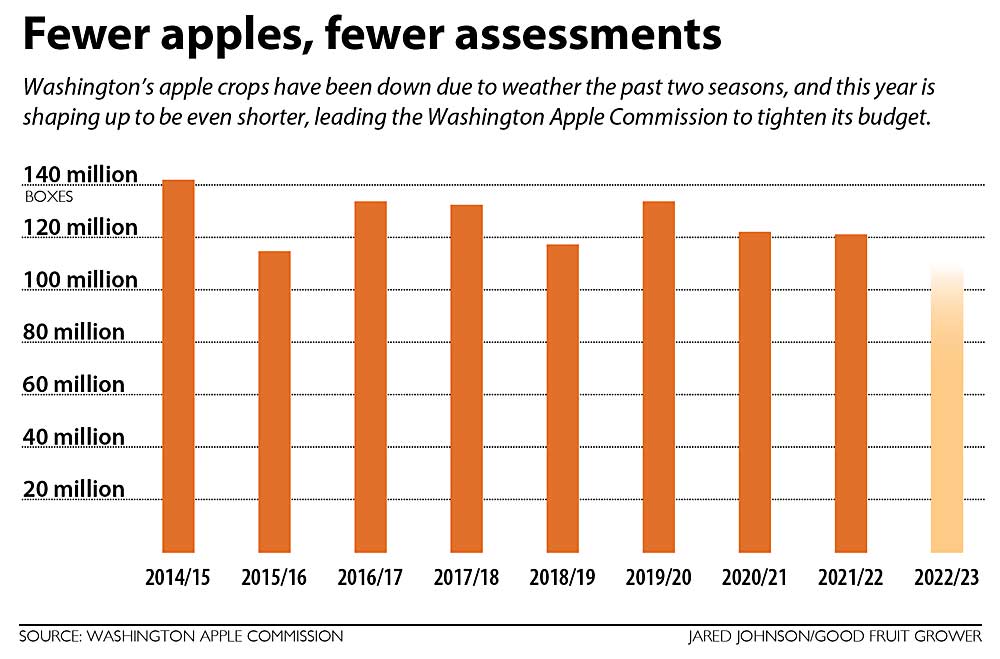
Apple industry leaders from across Washington predict a short crop this year, with estimates ranging from 100 million to 115 million boxes when the Washington Apple Commission’s board met in late May to discuss its budget for the year.
“It seems like nobody has a good crop,” said commissioner Jim Thomas.
That poses a challenge for the assessment-funded commission and the other industry organizations it channels grower money into: the U.S. Apple Association and the Northwest Horticultural Council.
At current budget levels, a break-even crop would be about 128 million boxes, commission Vice President Robin Mooney told the board during a meeting in Wenatchee on May 26. Crop size averaged about 130 million boxes from 2014 to 2019 but has been closer to 120 million the past two seasons.
The short-term solution is to temporarily reduce the board-designated reserve, covering the expected $700,000 shortfall in the organization’s $4.7 million budget, President Todd Fryhover said, a move he likened to “a Band-Aid.” Apple commission money is used as an industry match to leverage export marketing funds from the U.S. Department of Agriculture, he said, such that $2 million from growers gets $5 million in Market Access Program funding, for example.
This is also the final year of a second USDA program designed to mitigate impacts of retaliatory tariffs in 2018, known as the Agricultural Trade Promotion Program, or ATP, which required a grower match of 10 percent, Fryhover said. Next year, without the need to match that program, a breakeven crop will be 125 million boxes, he said in a follow-up call.
Citing the importance of the export marketing efforts, the commissioners discussed ways to tighten the belt across the board.
“If we have to trim the WAC budget, growers are going to want us to have to trim back the other budgets we’re dealing with,” said commissioner Bob Mast, president of CMI Orchards.
That includes the $600,000 for Northwest Horticultural Council dues and the $1.2 million marked for USApple dues. Together, those comprise about 40 percent of the apple commission’s budget.
Washington growers fund about 60 percent of the national group’s budget, said Jim Bair of USApple, who attended the Wenatchee meeting via video conference.
Dues are assessed at 7 mils per bushel, based on a five-year average of crop size for each region, which helps the organization maintain a more stable budget, Bair said.
Bair told the group that USApple works very hard to be careful stewards of grower dollars and has continued its operations without raising its budget in recent years.
The board voted to cap the USApple assessment at $1 million for the next three years, while keeping the hort council’s funding in place, recognizing the critical work the organization does on export market access. It also voted to decrease the board-designated reserve from $4 million to $3 million, to give the commission more working capital.
“Nobody is cutting USApple because they don’t see value,” Fryhover said in a follow-up call. “It’s just being financially responsible to the grower base. The board has done a great job protecting the growers’ assets and protecting the export programs.”
With the apple commission’s decision coming after USApple’s board approved its budget for the year, Bair said that to offset the reduction they may have to dip into reserves that currently represent 85 percent of annual operating expenses.
Other updates
Also at the meeting, Stephanie Bowman, Washington Gov. Jay Inslee’s liaison to the maritime industry and a former Port of Seattle commissioner, shared an update on the ongoing contract negotiations with the longshoremen and the impact on the region’s export supply chain.
Bowman said the contract between the International Longshore and Warehouse Union and the Pacific Maritime Association expires June 30. Although negotiations appear to be progressing, her advice to fruit exporters is to “prepare for the worst and hope for the best,” she said.
In 2014, the port slowdown cost the tree fruit industry tens of millions of dollars, Fryhover said.
Bowman said that, as shippers look for alternatives, the West Coast ports are already seeing a small percentage of cargo diverted via freight to East Coast ports.
“Nobody wants to see a slowdown,” she said. “But there’s not a lot we can do from sitting in the bleacher seats up here.”
One piece of good news on the export situation came from Jon Wyss, the Washington state director for the USDA’s Farm Service Agency.
At the Port of Seattle and Port of Oakland, the FSA is launching a pilot program to reimburse some of the costs produce exporters incur when forced to move refrigerated shipping containers due to delays.
“Your sales and marketing companies will be able to apply for those reimbursed costs on behalf of growers,” he said, to the tune of $400 per container. Training on how to apply for the financial support is expected shortly.
Wyss also updated the board on the heat disaster relief program that the agency just approved. Growers who filed a crop insurance claim last season should watch for a letter from the FSA, which has calculated the relief claim based on the data in those insurance claims. A second round of the program, expected later this year, will go to growers who didn’t have crop insurance or ended up not making a claim, he said. Training is also planned to help growers navigate the program in the coming weeks, he said. •
—by Kate Prengaman






Leave A Comment